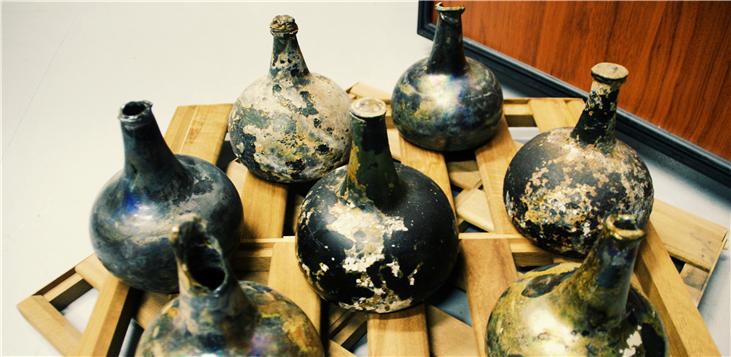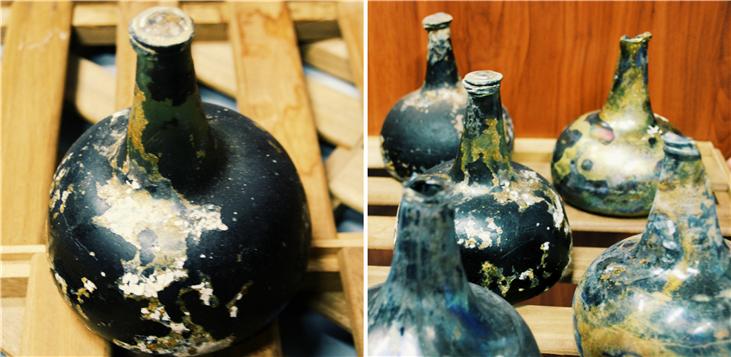At Belgium Wine Watchers we love a good wine story. One of our favourite ones is about the wines of the ship ’t Vliegent hart or Flying Heart. The ship was an 18th century East Indiaman of the Dutch East India Company. On the third of February 1735 ’t Vliegent Hart, which was on its way to Batavia in the East Indies, sank with the loss of all hand off the coast of Zeeland. She was carrying gold and silver coinage for trading, building materials and a few thousand bottles of wine.
The Dutch United East India Company
The Dutch United East India Company or Nederlandse Verenigde Oost-Indische Compagnie (VOC) was founded in 1602 on the initiative of the Dutch statesman Johan van Oldenbarneveldt. The Patent of the States General ended a fierce competition between trading companies.
The VOC consisted of six chambers: Amsterdam, Middelburg, Delft, Rotterdam, Hoorn and Enkhuizen. Amsterdam had a participation of 50% in the VOC and also the most representatives in the Executive Committee. So they had the majority when making decisions.
The trading monopoly between the Cape of Good Hope and the Strait of Magellan made the VOC very prosperous. But in the second half of the 18th century the VOC fell into decay caused by corruption, payment of too high dividends and the increasing competitions of other countries. In 1796, when the debts of the VOC reached the sky, the management was replaced by the government. Two years later the VOC was taken over definitely, which meant the end of a ‘multinational’ company.
’t Vliegent Hart
On the third of February 1735 the ships ’t Vliegent hart and Anna Catherina left the Roads of Rammekens. During the springtide the two ships, accompanied by the pilot boat Mercurius, sailed in the direction of the Isle of Wight. From there, they would sail to the Cape of Good Hope. There was a strong north-eastern wind.
Three hours after they left the harbour the ships hit a sandbank. The Anna Catherina and it’s crew of 175 people went aground. Within two hours the ship was wrecked by the storm and the waves. ’t Vliegent Hart broke adrift and cast anchor on the Schooneveld, near Zeeland. The crew did everything they can but all was hopelessly lost. The ship and its crew of 256 tragically drowned.
Due to the storm and high waves the pilot boat Mercurius couldn’t help, and returned to the Roads of Rammekens. Two months later the Chamber of Zeeland asked famous cartographer Abraham Anias to chart the position of the wrecks. In 1735 and 1736 they were in touch with many salvage operators who tried to salvage the cargo but very little was recovered. The salvaging wasn’t easy because the cargo was light it was scattered everywhere. In April 1736 they - amongst other things - brought up 591 bottles of white wine and 256 bottles of red wine.
’t Vliegent Hart fell into oblivion. But in 1975 Professor Dr. G. G. Schilder ‘rediscovered’ the wreck in the archives of the Library of the University of Leiden.
The present salvage of ’t Vliegent Hart
Every summer from 1979 until 1981 the diving expedition led by John Rose and Rex Cowan, explored several square miles of the Schelde. As the Deurloo has treacherous currents and narrow navigational channels with shifting sandbanks, this was a dangerous task. The underwater visibility is also very poor so an electronic sensing instrument was used.
The team used two boats and lived aboard. At night the boat returned to the Vissershaven in Flushing. The trip to and from the target area took up around six hours. In August 1981 the divers finally found the wreck. A part could be explored immediately thanks to reasonable weather conditions. They recovered some coins and artefacts.
In 1982 a steel ocean going catamaran was built especially for John Rose. A team of English and Dutch divers and diving archaeologists was assembled with the help of the Rijksmuseum and under the guidance of curator Bast Kist. It was from here that a number of bottles of wine was brought up, together with many artifacts, bullets and coffers with gold and silver coins. A metal grid was placed on the seabed so that the excavation could be done methodically. The Rijksmuseum carried out the registration and conservation of the finds.
The poor underwater visibility, old fishing nets ready to trap the unwary diver, seamen who destroyed the upper layer of the site with heavy trawlers on several occasions, mooring buoys that had been cut … The work of excavation and survey sure wasn’t without troubles.
The wines of ’t Vliegent Hart
It’s remarkable how many different bottles with wine have been found when salvaging ’t Vliegent Hart. In the list of the victuals they mention French, Spanish and Cape wines.
The Cape wines were only taken on board when passing the Cape of Good Hope. For this purpose they planted enormous quantities of vines in the Cape Colony. According to the data still available there were 5.265.000 vines in the Cape in 1768. The VOC even had their own wine cellars in Southern Africa. The founder of the Cape Colony, Jan van Riebeeck, is still considered - together with Simon van der Stel - to be the father of the viniculture in South Africa.
The chambers of Amsterdam and Zeeland had their own bottling rooms. So it’s credible that the bottles found on the wreck had been bottled by the chamber of Zeeland in Middelburg.
Cash books of the VOC show us that the French wines were often from Bergerac, Bordeaux and the Loire. The Spanish wines or ‘secq' wines came from the sherry area and the islands in the Atlantic Ocean. ‘Secq’ does not mean ‘dry’. It’s probably derived from ‘sack’, which in its turn would be derived from ‘sacar’ meaning ‘to export’. Furthermore many wines came from Germany (Rhine wines).
The bottles found in ’t Vliegent Hart resemble the form of a carafe, which is characteristic for the beginning of the 18th century. The modern form of corked wine bottles was only invented at the end of the 17th century. The wine bottles on board were probably made in Middelburg, the first Dutch town where bottle-factories were founded.
Historically seen it is unique that this variety of bottles with contents have been found. The illustrate perfectly the nature of wine and bottling in the 18th century.
A collector's item
At Belgium Wine Watchers we are always on the lookout for unique items. When we got hold of some exclusive wine bottles from ‘t Vliegent Hart, we could hardly believe our luck. We have bottles that are still closed and full of wine, other bottles are broken but nevertheless very beautiful. Of course the wine in these bottles is no longer drinkable but you must admit: it would make your collection more exclusive.
The bottles are not presented on our website because we only sell them on request. Each bottle is also unique in appearance. Are you interested in purchasing one these historic bottles? Don’t hesitate to contact us for more information.
Blogpost based on the booklet accompanying the certificate.





